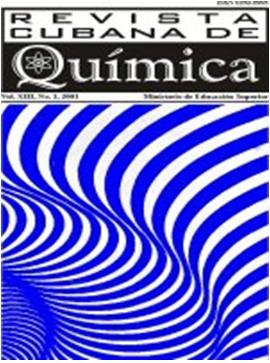Evaluación fitoquímica, y antimicrobiana del aceite esencial y los extractos de las hojas de Amyris elemifera L. (Coaba amarilla)
Resumen
Amyris elemifera L. es una planta aromática que crece en Cuba, de la cual no se han reportado estudios químicos ni farmacológicos en el país; por consiguiente, se exploró su composición química y actividad antimicrobiana. El extracto etanólico (EE) fue fraccionado sucesivamente con hexano (HF), acetato de etilo (EaF) y butanol (BF) caracterizándose fitoquímicamente. El EE, así como sus fracciones fueron evaluados conjuntamente con el aceite esencial (EO) obtenido por hidrodestilación; en su actividad antimicrobiana frente a dos bacterias, una levadura y tres parásitos a través del método de microdilución en placas. Fenoles, Alcaloides, Flavonoides, Triterpenes y esteroides, Cumarinas, Quinonas y aminas fueron los principales metabolitos detectados. EE, HF, EaF y el EO clasificaron con buena actividad antiparasitaria con valores de IC50 bajo los 20μgmL-1, mientras que BF no resultó activo. El índice de selectividad de EaF contra Lehismania Infantum clasificó como aceptable.Palabras clave: Amyris elemifera, tamizaje, aceite esencial, actividad antimicrobiana, Lehismania infantum.
Citas
JIANG, H.; YANG, S.; XIA M.; ZHEN-JI, W.; QIN-JIE, Z. "Limonoids isolated from Toonasinensis and their radical scavenging, anti-inflammatory and cytotoxic activities". Journal of Functional Foods. 2016, 20, 1-9. ISSN: 0031-9422
UVARANI, C.; SANKARAN, M.; JAIVEL, N.; CHANDRAPRAKASH, K.; ATA, A.; MOHAN, P. "Bioactive Dimeric Carbazole Alkaloids from Murraya koenigii". Journal of Natural Product. 2013, 76(6), 993-1000. ISSN: 0163-3864
MEHDI, B; ERELL, L.; BORGNE, B.; NADEGE, L.; OLIEVER, L.; LAURENT, M.; KHALIJAN, A.; MARC, L. "Acridone Alkaloids from Glycosmischlorosperma as DYRK1AÑ Inhibitors". Journal of Natural Products. 2014, 77, 1117−1122. ISSN: 0163-3864.
LIN, M.; CHENG, CH.; CHEM, K.; LEE, W.; WANG, Y.; XIAO, C.; LIN, C. "Induction of ROS-independent JNK-activation-mediated apoptosis by a novel coumarin-derivative, DMAC, in human colon cancer cells". Journal of Chemico-Biological Interactions. 2014, 218, 42-49. ISSN: 0009-2797
PENG, J.; HARTLEY, R.; FEST, M. Mooberry SL. "Amyris ins A-C, O-prenylated flavonoids from Amyris madrensis". Journal of Natural Products. 2012, 75 (3):494-6. ISSN: 0163-3864
PATIÑO, L.; PRIETO, R.; CUCA, S. "Zanthoxylum Genus as Potential Source of Bioactive Compounds". Bioactive Compounds in Phytomedicine. 2012,185-218. ISBN: 978-953-307-805-2
GRETCHEN, E.; JUNWEI, Z.; BARTHOLOMAY, L.; JOEL, R. " Amyris and Siam-wood Essential Oils: Insect Activity of Sesquiterpenes". Pesticides in Household, Structural and Residential Pest Management. 2009. Doi:10.1021/bk-2009-1015.ch002
BADALA, S.; WILLIAMS, S.; HUANGC, G.; FRANCISA, S.; VENDANTAM, P.; DUNBAR, O.; JACOBS, H.; TZENG, T.; GANGEMIC, J.; DELGODA, R. "Cytochrome P450 1 enzyme inhibition and anticancer potential of chromene amides from Amyris plumieri". Fitoterapia. 2011, 82(2), 230–239. ISBN: 978-81-308-0562-7
PENG, J.; HARTLEY, R.; FEST, G.; MOOBERRY, S. "Amyrisins A-C, O-prenylated flavonoids from Amyris madrensis". Journal of Natural Products. 2012, 75(3), 494-496. ISSN: 0163-3864
MEEPAGALA, K.; SCHRADER, K.; BURANDT, CL.; WEDGE, D.; DUKE, S. "New class of algicidal compounds and fungicidal activities derived from a chromene amide of Amyris texana". Journal Agric Food Chemistry. 2010, 58(17), 9476-82. ISSN 1432-0800
OCHOA, A; LÓPEZ, T; COLOMBAT, M. Farmacognosia y Química de los Productos Naturales. Monografía. ISBN 959-207-049-0. Editado en CD-ROM ISBN 959-207-012-1.4/2/2002, 2002.
COS, P; VLIETINCK, AJ; VANDEN, D; MAES, L. ”Anti-infective potential of natural products: How to develop a stronger in vitro ‘proof-of-concept’. Journal of Ethnopharmacology. 2006, 106, 290–302. ISSN: 2407-3733
ADAMS, R; ZANONI, T; VAN, B; POSTHUMUS, M; VAN DE HAAR, C. “Essential Leaf Oil of Amyris diatrypa Sprengel from the Dominican Republic”. Journal Essent of Oil Res. 1998, 10, 175-178. ISSN: 0976-5026
SWAMI, S; SINGH, SP; LONGO, G; DUTT, D. “Extraction Technologies for Medicinal and Aromatic Plants”. United Nations Industrial Development Organization and the International Centre for Science and High Technology. Trieste, Italy; 2008, 21-52, 115-127. ISSN 2277-1808
BERTHANA, CS; JANUARIO, A; ALVARENGA, T; PIMIENTA, L; ANDRADE, M; CUNHA, W; MENDOCA, P. “Quinone and Hydroquinone Metabolites from the Ascidians of the Genus Aplidium”. Marine Drugs 2014, 12, 3608-3633. ISSN 1660-3397
MINISTERIO DE SALUD PÚBLICA. NRSP No. 309. Medicamentos de origen vegetal: droga cruda. Métodos de ensayos. La Habana: MINSAP, 1992. ISSN 2224-5421
BHATT, V.; KUMAR, V.; SINGH, B.; KUMAR, N. “A new geranylbenzofuranone from Zanthoxylum armatum”. Natural Product Communications. 2015, 10(2), 313314. ISSN: 1555-9475
HALL, C.; T. HOBBY, M. CIPOLLINI. “Efficacy and Mechanisms of α-Solasonine-and α-Solamargine Induced Cytolysis on Two Strains of Trypanosoma cruzi”. Journal of Chemical Ecology. 2006, 32 (11), 24052416. ISSN: 1573-1561
YANG, G.; CHEN, D. “Alkaloids from the Roots of Zanthoxylum nitidum and their antiviral and antifungal effects”. Chemistry & biodiversity. 2008, 5, 1718-1722. ISSN:1612-1880
CAMPOS, M.; SALOMO, K.; CASTRO-PINTO, D.; LEON, L.; BARBOSA, H.; MACIEL, M.; DE CASTRO, S. “Croton cajucara crude extract and isolated terpenes: activity on Trypanosoma cruzi”. Parasitol Research. 2010,107(5),1193-204. ISSN: 1432-1955
FRANÇA DA SILVA, C; PACHECO, A; ALVES, R.; TAVARES, J; SOBRAL DA SILVA, M; ESCALONA, JC. “Anti-trypanosoma cruzi activity in vitro of phases and isolated compounds from Excoecari alucida Leaves”. Medicinal Chemistry, 2018, 14, 1-7. ISSN: 1573-4064
LOPEZ, D; BIZZO, H; SOBRINHO, A.; PEREIRA, M. Essential Oil from Leaves of Croton sacaquinha. Journal Essent Oil Res. 2003, 15,48-9. ISSN: 0976-5026
GARCÍA, J; ESCALONA, JC; JAÉN, DG; MONZOTE, L; DE LA VEGA, J; BIDAR DE MACEDO, M.; COS, P. “Antileishmanial potentialities of Croton linearis leaf essential oil.” Natural Product Communications. 2018, 13 (5), 629-634. ISSN: 1555-9475
Descargas
Publicado
Cómo citar
Número
Sección
Licencia
Esta revista proporciona un acceso abierto inmediato a su contenido, basado en el principio de que ofrecer al público un acceso libre a las investigaciones ayuda a un mayor intercambio global de conocimiento. Cada autor es responsable del contenido de cada uno de sus artículos.























